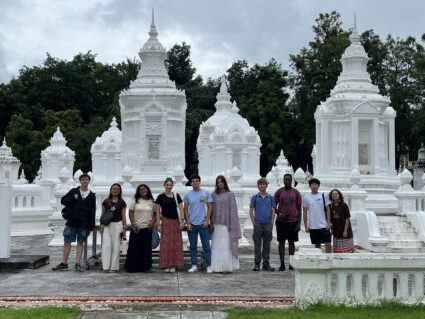



As we spend our last couple of days here in Chiang Mai, we sit in gratitude for this beautiful country that has been our home the last 3 months. While words might not be enough to thank this beautiful country, its generosity, its people, and all the lessons it has provided all of us, students wanted to thank Chiang Mai and Thailand. Below are their thank you notes.
Michela:
Thank you, Huai Lan. I cannot begin to express how much gratitude I hold for Huai Lan and my family there. They say it takes a village to raise a child- I felt that there. Here I was curious and new and lacking all the language I wanted at my fingertips; and Huai Lan was the village that took me in wholeheartedly. Mae Tim, before I left told me not to forget my boots or my heart and I definitely left both behind. I am beyond lucky to have been taken care of on opposite sides of the globe. Thank you for mountain mornings and peeled fruits and dancing and big breakfasts and everything else. I will miss this pretty country immensely and its people even more so.
Nelson:
Thank you, Chiang Mai for the home you have given me in the past three months. Thank you for showing me your beauty – both nature and the people. Thank you for bustling night markets. Thank you for the cheap drinks I get the opportunity to buy every day. Thank you Huai Lan- words can’t begin to describe how thankful I am for my experiences. Thank you doodle- I’ve made so much memories with you. Thank you old city – our time was short but cherished every moment. Thank you for the people in Huai Lan, CVS cohort, Dragons instructor, list goes on….
Belen:
Thank you Thailand for the food, for the connections you allowed me to form with people from completely different culture and background, for the experience of living in a city, for the experience of seeing the most beautiful landscapes I have ever seen, for allowing me to see elephants, for allowing me to learn a beautiful and unique language. Thank you for showing me that genuine kindness is found everywhere even 13,000 miles away from home. Thank you for the support that I have found from friends and instructors. Thank you for giving me the most challenging conflicts in order to learn and grow from them. Thank you for everything.
Vorleak:
Thank you Thailand for showing me that love can be given from anywhere in the world regardless of how different we are. Thank you for giving me one of the greatest food journeys I’ve had in so long. My belly is sizing up pretty fast. Thank you Thailand for giving me the most amazing and most loving host mom and host community I could ever ask for. Thank you Thailand for taking great care of me these past three months. Thank you Thailand for letting me walk on your street and create memories along the way. I will come back.
Alonso.
-Thank you Thailand for teaching me about the struggles of the indigenous people.
-Helping me to understand the value of traveling.
-Reinforcing the idea of listening to multiple perspectives.
-Showing me the importance of speaking out for myself and people in vulnerable positions.
-Helping me to deepen my understanding of empathy.
-Allowing me to meet and share time with some people I consider friends .
Jake
Thank you Thailand for the lovely people; the patience and kindness. Thank you for the beauty; the stunning landscapes topped with gorgeous buildings and temples. Thank you for the action; wild tuk-tuk rides and soccer games. Thank you for the memories.
Karlita
Thank you Chiang Mai!
-For the fun tuk-tuks that make your hair go all over the place.
– For the amazing cafés (shout out to nes Café) that serve delicious lattes.
-For allowing me to meet my wonderful mom that I love so much.
-Endless soccer matches with new thai friends.
-For allowing me to grow as a person .
Amos
Thank you Thailand!
Through Thailand experience, I have learned to appreciate everyone, practice kindness, and embrace one another. I have seen the beautiful heart people have here, and I am inspired. Walking in the markets, the warm embrace by the people, the beautiful weather and environment, makes Thailand, one of the most beautiful destinations!
Dani
Thank you Thailand!
Today on one of our final excursions to the blue Temple, I found myself asking Michela what they thought was the meaning of time? It came from how I was thinking that in a couple of days time we would be flying back to the respective lives that we all had before in places all around the world, but not Thailand. I found myself thinking of how three months ago we arrived and were driving in our LED lit vans not knowing the adventure that this amazing, kind country held for us. Not knowing the struggles we would face and how we would change as a result. Three months ago seems like not long ago, but we have lived so much, grown so much you would think we had been here 10 years, which begs the question: why does time pass?
Originally posted here.






